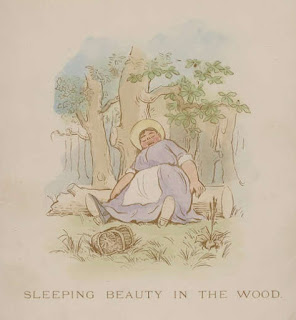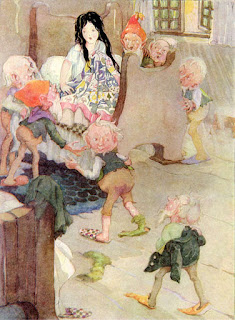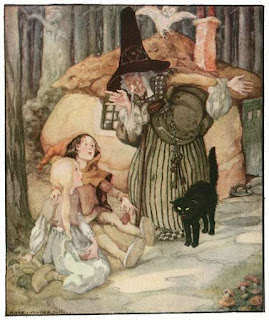Sleeping Beauty in Pictures
The Sleeping Beauty Images by Various Artists
The Sleeping Beauty is one of the classic fairy tales with long tradition, wide popularity, and numerous versions. Without a doubt, the theme of the sleeping princess is the most popular fairy tale theme in art of all time. Many artists used fairy tales to enhance the scene with symbolism and hidden messages or used a popular scene to interpret contemporary issues. This page presents the biggest collection of public domain pictures (author + 70 years) based on The Sleeping Beauty. You can use the images for virtually anything you want. If you find it useful, a link to this website (from your blog, social profile, social media, etc.) will be not only greatly appreciated but it will also motivate our team to add even more interesting content in the future.
One more thing - in general, there are two versions of the same fairy tale: Charles Perrault's The Sleeping Beauty in the Woods and Briar Rose by the Grimm Brothers, often fused into an Anglicized version of The Sleeping Beauty. That's why the titles of the drawings or the illustrated tales vary.
Illustrations and paintings of Sleeping Beauty are arranged in alphabetic order by the artists. Many of them also provide links to even more images by the same artist on the same theme or other useful information. Enjoy!
Frank Adams (1871-1944)
The illustration of Sleeping Beauty comes from My Nursery Book, published in 1930 by Blackie & Son, in London and Glasgow.
Anne Anderson (1874-1952)
Anne Anderson illustrated Briar Rose for Old, Old, Fairy Tales, published by Whitman Publishing Company, Racine, Wisconsin, 1935.
Hanns Anker (1873-1950)
We don't have any additional useful information on this illustration by Hanns Anker.
Honor Charlotte Appleton (1879–1951)
The illustration comes from Charles Perrault's Fairy Tales, published in 1919 by Simpkin-Marshall in London.
Martin 'Cynicus' Anderson (1854-1932)
This humorous colored engraving was created in 1891.
Leon Bakst (1866-1924)
Leyb-Khaim Izrailevich Rosenberg, better known as Leon Bakst, was a world world-famous stage and costume designer. This is just one of numerous illustrations for the stage production of Tchaikovsky's Sleeping Beauty.
Edouard de Beaumont (1821-1888)
This illustration is from 1887. It's one of four colored illustrations for otherwise richly illustrated Four Fairy Tales by Perrault published in the same year as the artist died. By the way, the date of birth for de Beaumont is not certain. Some sources claim it should be 1812. And we don't know who colored this illustration, because the book presents in two colors only.
Thekla Brauer (1856-1942)
Verlag Otto Spamer from Leipzig published this illustration of Briar Rose in 1895. The title of the book is 50 Children's and Household Tales.
William Arthur Breakspeare (1856-1914)
The original was made as oil on canvas, but most people are familiar with Breakspeare's painting in the form of a poster.
Edward Frederick Brewtnall (1846–1902)
Gordon Frederick Browne (1858-1932)
The illustration for Sleeping Beauty for Children's Stories from Tennyson is subtitled Prince Awakens the Sleeping Beauty. It was published by Raphael Tuck & Sons, London, around 1920.
Frances Brundage (1854-1937)
The illustration was published around 1900 in a picture book by Raphael Tuck & Sons as a part of the series illustrated by popular artists.
Gertrud Caspari (1873-1948)
The illustration above is from Caspari's last bigger project. It was published three years after her death in the book titled Come Into the Fairy Tale Kingdom (Alfred Hahn's Verlag). It was also republished in 2008 by Esslinger Verlag.
Henry Patrick Clarke (1889-1931)
Harry Clarke illustrated The Fairy Tales by Charles Perrault for George Harrap, London, in 1922.
Herbert Cole (1867–1930)
Edward Coley Burne-Jones (1833-1898)
The next two paintings are only half of the original Burne-Jones project titled The Legend of Briar Rose.
After the first four panels were completed in 1890, ten more followed when the artist already saw the originals hanging on the walls. This is not the only Briar Rose series by Sir Edward Coley Burne-Jones, though. There are at least two more!
John Collier (1850-1934)
Collier's painting The Sleeping Beauty is a typical example of the Pre-Raphaelite style from 1921.
Walter Crane (1845-1915)
Walter Crane loved to adapt fairy tales, designed all of the pages including the typography, and set new standards for the thriving picture book industry.
The illustrations above come from the 1876 edition and are only one of many collaborations between Crane and Edmund Evans, probably the most influential printer of the 19th century.
Elizabeth Curtis (1873 - 1946)
Curtis illustrated the image above for the Wonder Book of Fairy Tales, published in 1917 by Frederick A. Stokes Co., New York.
John Dickson Batten (1860-1932)
The scene of the princess' finger pricking was painted with egg tempera on the artist's board in 1897. The original hangs in Leicester's gallery. Its approximate measures are 70 cm times 100 cm.
Konrad Dielitz (1845-1933)
The illustration is from 1879 and it was made for one of the trade cards, popular at the end of the 19th and beginning of the 20th century.
Gustave Dore (1832-1883)
The presented set of illustrations is just a small part of Dore's take on fairy tales by Charles Perrault.
Edmund Dulac (1882-1953)
Dulac's illustration comes from The Sleeping Beauty and other fairy tales from the old French, published by Hodder & Stoughton, London, New York, in 1910. He made decorations as well.
John Duncan (1866-1945)
Duncan was a Scottish symbolist who mostly enjoyed portraying scenes from Arthurian legends and mythological themes. The theme of the sleeping princess perfectly fits this narrative.
Richard Eisermann (1853-1927)
Henry Justice Ford (1860-1941)
Henry Justice Ford was an extremely versatile and productive artist, yet most people will remember him only from the colored fairy tale books. This illustration is from the first book in the series (Blue Fairy Tale Book) but was added only in one of the later reprints in 1920 as the only color picture in the book.
Gustave Fraipont (1849-1923)
As you can see, this Belgian artist summarized the whole story with three illustrations in one sheet only. That's called efficiency.
Warwick Goble (1862-1943)
Paul Hey (1867-1952)
Paul Hey was an illustrator and postcard artist. He illustrated Briar Rose on several occasions.
This postcard belongs to the series with motifs from Grimms' fairy tales published by FA Ackermann in 1910.
The illustration above is from 1916. It was published by Thienemann Verlag. The next two are from 1939.
Gilbert Penrose James (1865-1941)
The illustration above is from Grimm's Fairy Tales, published around 1906 by Siegle Hill and Co. in London. The book contains only six fairy tales, with two of them being almost unknown to a wider audience.
Willy Juttner (1886-1940)
Juttner's illustrations have minimum amount of colors but aim for maximum contrasts.
The images above belong to Of Kings and Queens from 1921.
Nikolai Nikolayevich Karasin (1842-1908)
This oil painting is from 1889, and it's part of the private collection.
Eugen Johann Georg Klimsch (1839-1896)
It's a bit of a mystery when this illustration was made. Klimsch illustrated Grimms' fairy tales for Children's Fairy Tales, published in 1894 by Loewe Verlag, Stuttgart, but they were black and white. In 1923, the same company published Grimm's Fairy Tales with four color illustrations by Klimsch. This is one of them, and there is no data about its creation. It may be even possible it was colorized by somebody else.
Otto Kubel (1868-1951)
Kubel often fused illustrations for picture books and picture cards. The postcard above is one of a series of six.
Carl Larsson (1853-1919)
Carl Larsson was primarily a painter, but the illustration above is probably from his earlier years when he tried to survive by illustrating books and magazines. His most important works, however, are - frescoes.
Curt Liebich (1868-1937)
The illustration comes from Sleeping Beauty and Other Fairy Tales, published by Abel & Müller Verlag from Leipzig in 1925.
Frederic Theodore Lix (1830-1897)
The image above comes from Perrault's Fairy Tales, published after the artist's death, probably in 1904.
Ernst Emil Lohse (1885-1949)
Lohse was very active in different areas of art, culture, and history.
The scene with the prince inquiring about the mysterious castle was published as a part of the artist's portfolio titled Over the Mountains - 12 pictures by Emil Lohse based on fairy tales by the Brothers Grimm in 1946.
Ann MacBeth (1875 - 1948)
William Henry Margetson (1861-1940)
We have found four illustrations of Sleeping Beauty by Margetson.
These two belong to Stories from Grimm, published in 1904.
These two are from The Old Nursery stories, from 1909.
Achille Lucie Mauzan (1883-1952)
Mauzan worked in France, Italy, and Argentine. He is mostly known as poster artist. He was especially successful with movie posters.
This postcard is part of the series about Sleeping Beauty, which was also a subseries of series of greeting cards with Perrault's fairy tales.Adrien-Emmanuel Marie (1848-1891)
Like many French illustrators, he illustrated The Fairy Tales by Charles Perrault.
We honestly have no idea when and why these three illustrations were made.
Paul Meyerheim (1842-1915)
Meyerheim started illustrating Grimms' fairy tales in 1870 with Wolf and Seven Kids in the so-called small edition. Four years later, all illustrations in the reprint were created by Meyerheim. This includes the illustration above.
The second image of Briar Rose is from 1887, made for the anthology by Bertelsmann Verlag, Munich.
Henry Meynell Rheam (1859-1920)
This impressive combination of pencil, watercolors, and gouache with approximately 120 cm times 75 cm dimensions from 1899 worth is estimated to be a quarter of a million dollars.
Clara Miller Burd (1873-1933)
Clara Miller Burd made an initial success as a stained-glass designer at Tiffany in New York. It's not clear on which occasion this illustration was created. We know that a variation (with a different border) of the same image was published in the New York Tribune in 1919, but we can't say which image was published first.
Paula Modersohn-Becker (1876-1907)
This is how an expressionist sees Briar Rose. The painting is from 1901.
William Morris (1834-1886)
We present only two of the sixteen titles created by William Morris after eight illustrations by Edward Burne-Jones between 1862 and 1865.
Karl Muhlmeister (1876-1942)
The illustration above was created for Ensslin & Laiblin from Reutlingen, a long-time publisher of Muhlmeister's works, yet we can't say when. Around 1920 seems a reasonable estimation.
Franz Muller-Munster (1867-1936)
Muller-Munster illustrated Briar Rose for different anthologies. Scholz Kunstler-Bilderbucher around 1904 would be our best guess at the moment.
Viktor Paul Mohn (1842-1911)
Both illustrations belong to the same book from 1882.
The title of the book is Fairy Tale Bouquet for Child and Home was published by Georg Stilke Verlag in Berlin.
Jenny Eugenia Nystrom (1854-1946)
Nystrom was mostly known for her picture card designs. This illustration was used by Raphael Tuck & Sons for their Christmas Postcard Series with a 'Happy New Year to you' inscription.
Carl Offterdinger (1829-1889)
Offterdinger illustrated Briar Rose in 1884 for German Fairy Tales for Children, published by Verlag von Wilhelm Effenberger, Stuttgart. This is not Grimms', but a Bechstein's version.
Arthur Rackham (1867-1939)
Rackham created several illustrations of Briar Rose and Sleeping Beauty.
The first illustration is from 1909. It was published in Grimm's Fairy Tales by Constable & Company in London. Other illustrations were created on different occasions for numerous reprints and revisions.
Roland Risse (1835-1900)
The original is an oil painting on canvas.
Charles Robinson (1870-1937)
The first illustration was published in 1900 by J. M. Dent & Company but as a black & white drawing. We don't know when it was colorized. The second picture belongs to Big Book of Fairy Tales, published in 1911 by Blackie & Son, London.
William Heath Robinson (1872-1944)
The illustration is from Old-time Stories, published by Dodd, Mead & Company, New York, in 1921.
Wilhelm Schafer (1839-?)
The Shaffer's illustration is one of five color illustrations from New Fairy Tales published in 1872 by Verlag Ernst Schotte & Co. in Berlin.
Matvey Andreyevich Shishkov (1832-1897)
Matvey Shishkov was a decorative painter and scenographer.
The picture above portrays a stage scene from Sleeping Beauty, a ballet by Pyotr Ilyich Tchaikovsky in 1889.
Franziska Schenkel (1880-1945)
The illustration belongs to the 1913 edition of Grimms' Fairy Tales.
Joseph Edward Southall (1861-1944)
The painting is from 1903 and is currently located in Birmingham.
Thomas Ralph Spence (1845–1918)
This is oil on canvas created around 1872.
Max Teschemacher (1910-1950)
It's an illustration from the picture book Sleeping Beauty, published by Alfo Kunstdruck Verlag in the 1940s. This is book number 2 in the series of 36 fairy tales by the Grimm Brothers.
Viktor Mikhaylovich Vasnetsov (1848-1926)
The title of this famous painting is The Sleeping Queen. Its dimensions are 215 cm times 450 cm!
Hermann Vogel (1854-1921)
The illustration was made and published in 1894, but it was very likely colored later.
Johann Heinrich Vogeler (1872-1942)
Vogeler created this tapestry in 1898 in the Art Nouveau style.
Ivan Alexandrovich Vsevolozhsky (1835–1909)
These sketches were created in 1890 for the Tchaikovsky's ballet.
Jessie Willcox Smith (1863-1935)
The illustration comes from A Child’s Book of Stories, published in 1913 by Chatto & Windus, London.
Alfred Joseph Woolmer (1805-1892)
This oil on board is a part of a private collection. Its dimensions are approximately 60 cm times 70 cm.
Alexander Zick (1845-1907)
Zick created this illustration around 1880 for Fairy Tales for Kids, published by G. Grote'sche Verlagsbuchhandlung in Berlin.
Ernst Zimmer (1864-1924)
Briar Rose is one of six fairy tales illustrated by Zimmer in 1904 for The Most Beautiful Fairy Tales of the Brothers Grimm, published by Jugendhort in Berlin.
Walter Zweigle (1859-1904)
This is the longest list of free pictures and illustrations of Sleeping Beauty. Please share it with the rest of the world. Thanks!

































































































Komentarji
Objavite komentar